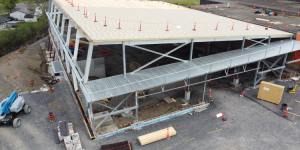For 25 years Clark Johnston has been a roofing contractor with a mission — he doesn’t want to work on a roof he will have to work on again.
The owner of Clark’s Tile Roofing in Vernon, B.C. prefers to work in clay, concrete and slate, materials that will outlast him and most likely the 21st century as well.
"For seven years I learned roofing from a German master roofer who specialized in permanent roofs," he says.
"When I started my own company in 1991, I always knew that it was going to be tile."
His specialty trade has taken him to projects as far afield as Jasper, Alta. and Hamilton, Ont.
For many customers choosing a roofing material comes down to price. Concrete tiles are roughly twice the price of asphalt shingles, clay tiles are about 50 per cent more expensive than concrete and slate tiles are twice the price of clay.
Most of Johnston’s work is in concrete followed by clay, with occasional slate jobs rounding out the schedule.
Permanent roofing solutions are heavier than asphalt, so beginning one of these projects means consulting with a structural engineer who will determine if roof trusses have the strength to safely support the load.
Lightweight roofing materials weigh less than six pounds per square foot, while clay tiles weigh double that.
Underperforming roof trusses must be beefed up prior to installation.
Johnston sources concrete tile locally, but must be careful about where he buys clay tile.
"Anywhere that you have plenty of sunlight and a freeze/thaw cycle puts plenty of strain on clay tile," he says.
"In the Okanagan Valley you get summer temperatures of 90 F-plus and cold winters, so it’s no exception. If I ordered a clay tile from California and installed it here, it would begin cracking and spalling quickly."
On the other hand, European tiles are designed for just such a climate.
"They’re fired and glazed like a teacup," he says. "They’re very hard, not prone to leaks and keep their colour under the sun. Some Spanish clay tiles are particularly good."
Over the years, clay tile roofing installation methods have changed. In the 1990s, the clay tiles were installed directly on roof strapping as a floating roof.
The tile hips and ridges were sealed with mortar. Contractors are now required to put down plywood sheeting and cover it with building paper prior to installation.
For clay tile roofing projects, Johnston typically fashions his flashing in-house from copper.
Given clay’s longevity, it makes sense to provide a flashing material that can also last up to three centuries.
The less expensive concrete tiles are easier to cut than clay using a diamond cutter and these projects typically don’t involve copper work.
"If you’re choosing concrete, you’re typically more cost conscious," says Johnston.
"You’re probably choosing concrete because it’s a financial strain to make it to the clay ballpark."
Slate tiles are generally cut from quarries located in the Maritime provinces.
Johnston notes that the source rock formations are the same as those found in Wales and used on British roofs, hearkening back to the days before continental drift separated Europe from North America.
"When people ask me how long slate tiles will last, I tell them that they’re already a million years old on delivery and that they’ll probably last a million years more," he says.
"I’m the local slate specialist, so people in the area usually ask for me by name on these projects."
Two employees at Clark’s Tile Roofing have been with the company for a dozen years and are committed to learning the permanent roofing trade.
For other employees it’s a revolving door, says Johnston.
"When they have to hump a heavy load of clay tiles up a roof with a 12/12 pitch many of them don’t stick around long," he says.
"The projects I worked on while I was apprenticing are still there. If that means something to you as a roofer, than the effort should be worth it."

Clark’s Tile Roofing is located in Vernon, B.C. The contractor’s work is mostly in concrete followed by clay, with occasional slate jobs rounding out the schedule.
Photo: Chris Hendry"










Recent Comments
comments for this post are closed